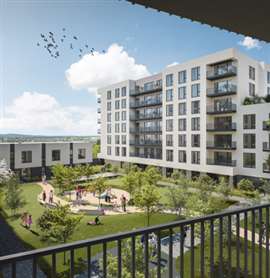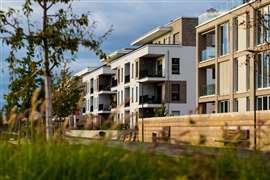EU’s largest residential ‘passive house’ complex
19 September 2024
Cairn Homes – an Ireland-based construction company – said its Pipers Square complex in Dublin, Ireland, will be the European Union’s (EU) largest residential passive home complex once complete next year.
 Render of Pipers Square passive home complex in Dublin, Ireland. (Image courtesy Cairn Homes)
Render of Pipers Square passive home complex in Dublin, Ireland. (Image courtesy Cairn Homes)
The Pipers Square complex will include 598 units, which developers believe will produce 40% savings on energy bills, while maintaining a constant interior temperature of 20-degree Celsius throughout.
The residential complex is expected to open in June 2025.
Cairn is currently working on three other massive passive house projects, all in the Dublin, Ireland area: a 608-unit complex called Seven Mills (to open June 2025), a 255-unit complex named Whitehaven (due open in March 2026), and Niven Oaks – a 268-unit project set to open in June 2026.
A value for the projects was not provided.
What are passive homes?
Passive homes are defined as structures built to voluntary conforming standards that subsequently use less energy for space-heating and space-cooling, ultimately lowering the carbon footprint.
Specifically, to be considered a passive home, the structure must:
- Use up to 15 kWh/m2 of floor area annually for heating and cooling (as calculated by the Passive House Planning Package), or a peak heat load of 10 W/m2 of floor area, based on local climate data.
- Use up to 60 kWh/m2 of floor area annually for primary energy including heating, hot water and electricity.
- Leak air up to 0.6 times the house volume per hour at 0.0073 psi as tested by a blower door, or up to 1.4 L/min per sq ft of the surface area of the enclosure.
Passive homes can differ from conventional homes in their architecture and specialised ventilation systems, as well as typically thicker-than-average walls and insulation. Passive homes, depending on where they are built, can cost up to 10% more than a conventional build.
Exact regulation (if any is established) on qualifying homes as “passive” varies country-to-country.
 A housing complex in Heidelberg, Germany, that was built to Passive House Standard. (Image: Adobe Stock)
A housing complex in Heidelberg, Germany, that was built to Passive House Standard. (Image: Adobe Stock)
STAY CONNECTED



Receive the information you need when you need it through our world-leading magazines, newsletters and daily briefings.
CONNECT WITH THE TEAM








